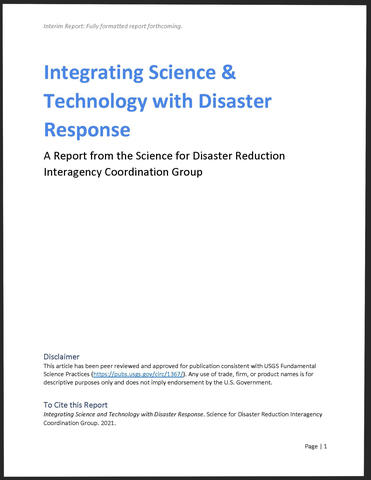Integrating Science & Technology with Disaster Response
A Report from the Science for Disaster Reduction Interagency Coordination Group

Each year, communities across the United States are devastated by disasters. As the frequency, severity, and cost of many of these disasters continues to increase, new collaborations and innovative solutions are needed to reduce risk. Many Federal and academic science and technology (S&T) capabilities are already integrated into disaster prevention, mitigation, response, and recovery. For example, highly accurate weather reports are critical to fighting wildfires, and evacuating communities in advance of hurricanes. GIS and remote sensing technologies have proven invaluable for better understanding the extent and potential impact of flooding, as well as damage from earthquakes and other disasters. More can be done, however, to incorporate S&T capabilities from all quarters into disaster response in order to provide critical tools and information to first responders and decision-makers. Steps can be taken to ensure that S&T improves over time in ways that support better decisions and preparedness for future hazards and disasters.
This report is divided into two sections. The first, aimed at the emergency management community, summarizes what S&T capabilities currently exist to aid in U.S.-based disaster response, how these capabilities are coordinated across the Federal family and the interorganizational community, and how these assets are mobilized and funded. Here the report demonstrates the power of S&T in disaster response, and how it may be integrated more effectively into the Incident Management System. It also highlights the importance of allowing scientists and engineers to conduct certain types of research during response. Many scientific endeavors need not be carried out during, or immediately following, a disaster event, but certain ephemeral or perishable data like the baseline health of first responders should be collected in order to inform future responses, or ongoing consequences of the present response. Perishable data can also be used to help scientists and engineers learn important lessons from disaster events. For example, knowing what engineering solutions worked or failed during a severe weather event can inform future building codes and lead to more resilient infrastructure. Allowing critical research or data collection to take place amid the unique environment of a disaster-affected area places new demands on the scientific, engineering, and response communities for communication, training, and coordination.
The second section of the report is aimed at members of the scientific and engineering communities who may be interested in conducting research during disasters. It outlines important considerations for operating within a disaster-affected area. These considerations include safety, community sensitivities, and avoiding placing further burdens on impacted areas by maintaining self-sufficiency. Respectful and clear communication and collaboration between the research and emergency management communities are also underscored. It outlines a series of challenges for advancing the integration of S&T capabilities for response.
The scientific and emergency management communities have already made great strides in increasing collaboration, facilitating communication, and defining rules of engagement during disasters. Despite the different emergency management and scientific research cultures, relationships and integrated approaches are key to fully capitalizing on the use of S&T resources for disaster response.

